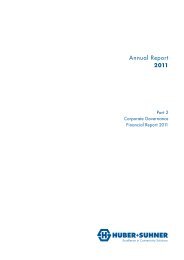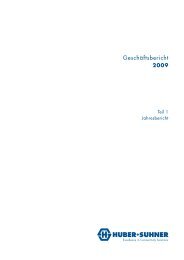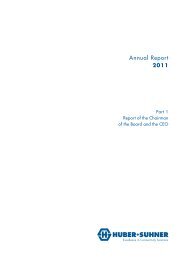Annual Report
Annual Report
Annual Report
You also want an ePaper? Increase the reach of your titles
YUMPU automatically turns print PDFs into web optimized ePapers that Google loves.
Notes to Group Financial Statements<br />
HUBER+SUHNER <strong>Annual</strong> <strong>Report</strong> 2010 · Part 2<br />
Financial assets as of 31 December 2009 Level 1 Level 2 Level 3 Total<br />
Marketable securities 15 574 26 710 – 42 284<br />
Derivative financial instruments – 1 853 – 1 853<br />
Financial liabilities as of 31 December 2009 Level 1 Level 2 Level 3 Total<br />
Derivative financial instruments – 590 – 590<br />
4 Critical accounting estimates and judgements<br />
Preparation of the consolidated financial statements in conformity with IFRS requires the Board of Directors and Group<br />
Executive Management to make estimates and assumptions, whereby such estimates and assumptions have an effect on<br />
the amounts stated under assets, liabilities, income and expenses. Estimates and assumptions are continually evaluated<br />
and are based on historical experience and other factors, including expectations and judgements of future events that<br />
are believed to be reasonable under the circumstances. These form the basis for reporting those assets and liabilities that<br />
cannot be measured directly from other sources and will not always correspond to the later actualities of the situation.<br />
The estimates and assumptions that may have a significant risk of causing a material adjustment to the carrying amounts<br />
of assets and liabilities within the next financial year are addressed below:<br />
Inventories<br />
When assessing inventories, estimates for their recoverability that arise from the expected consumption of the corresponding<br />
items are necessary. The adjustments for the inventories are calculated for each item using a systematic stock coverage<br />
analysis. The parameters are checked annually and modified if necessary. Changes in sales or other circumstances can lead<br />
to the book value having to be adjusted accordingly.<br />
Pension liabilities<br />
The net present value of pension liabilities and the plan assets at market value are based on several assumptions that are<br />
calculated on the balance sheet date using an actuarially based procedure. For these projections assumptions must be<br />
made regarding discount rate, expected yields from assets, salary and pension increases, staff fluctuations, etc. The assumptions<br />
are considered each year on the balance sheet date based on observed market data. These are the interest rates<br />
of bonds in the relevant currency with high creditworthiness as well as asset studies. Changing the assumptions mentioned<br />
could lead to significant deviations because of the long-term nature of these calculations.<br />
Provisions<br />
In relation to the operational business of the Group liabilities can occur out of warranty and damage claims, restructuring,<br />
employee related payments and legal disputes. Provisions for such liabilities are recognised based on the realistically<br />
anticipated outflow of funds at net present value on the balance sheet date. Depending on the changes and settlements<br />
in the corresponding businesses, the actual payments may be higher or lower than the recognised provision and may not<br />
or only be partially covered through a corresponding insurance benefit. Therefore the effective payments may differ from<br />
these estimates.<br />
Income taxes and tax accruals<br />
The Group is subject to income taxes in numerous jurisdictions. Therefore, significant judgement is required in determining<br />
the worldwide accrual for income taxes. There are many transactions and calculations for which the ultimate tax<br />
determination is uncertain during the ordinary course of business. The Group recognises liabilities for anticipated tax<br />
audit issues based on estimates of whether additional taxes will be due. Where the final tax outcome of these matters<br />
is different from the amounts that were initially recorded, such differences will impact the income tax and deferred tax<br />
provisions in the period in which such a determination is made.<br />
The related tax assets on losses carried forward are valued based on business plans. The capitalisation of usable tax losses<br />
carried forward is assessed on a yearly base. The tax losses carried forward are recognised considering country-specific<br />
fiscal regulations and the likelihood that they can be used during the next one to two years depending on the profit situation<br />
of the corresponding subsidiary. In counties respectively subsidiaries where the usage of tax losses carried forward<br />
is not foreseeable the capitalisation is not recognised.<br />
27
















